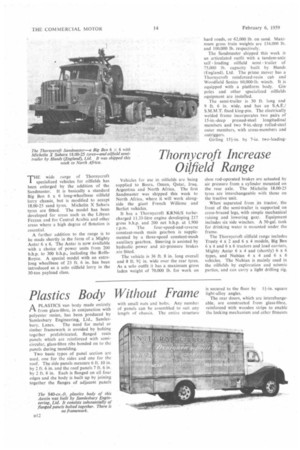Thornycroft Increase Oilfield Range
Page 54

Page 55

If you've noticed an error in this article please click here to report it so we can fix it.
THE wide range of Thornycroft
specialized vehicles for oilfields has been enlarged by the addition of the Sandmaster. It is basically a standard Big Ben 6 x 6 long-wheelbase oilfield lorry chassis, but is modified to accept 18.00-25 sand tyres. Michelin X Sahara tyres are fitted. The model has been developed for areas such as the Libyan Fezzan and for Central Arabia and other areas where a high degree of flotation is essential.
A further addition to the range is to be made shortly in the form of a Mighty Antar 6 x 6. The Antar is now available with a choice of power units from 200 b.h.p. to 300 b.h.p., including the RollsRoyce. A special model with an extralong wheelbase of 23 ft. 6 in. has been introduced as a solo oilfield lorry in the 30-ton payload class. Vehicles for use in oilfields are being supplied to Basra, Oman, Qatar, Iraq, Argentina and North Africa. The first Sandmaster was shipped this week to North Africa, where it will work alongside the giant French Willeme and Berliet vehicles.
It has a Thornycroft KRN6/S turbocharged 11.33-litre engine developing 217 gross b.h.p. and 200 net b.h.p. at 1,900 r.p.m. The four-speed-and-reverse constant-mesh main gearbox is supplemented by a three-speed constant-mesh auxiliary gearbox. Steering is assisted by hydaulic power and air-pressure brakes are fitted.
The vehicle is 36 ft. 8 in. long overall and 8 ft. 91 in. wide over the rear tyres. As a solo outfit it has a maximum gross laden weight of 70,000 lb. for work on
hard roads, or 62,000 lb. on sand. Maximum gross train weights are 134,000 lb. and 100,000 lb. respectively.
The Sandmaster shipped this week is an articulated outfit with a tandem-axle self loading oilfield semi trailer of 75,000 lb. capacity built by Hands (England), Ltd. The prime mover has a Thornycroft reinforced-resin cab and Woodfield Senior 60,000-lb. winch. It is equipped with a platform body. Gin poles and other specialized oilfields equipment are installed.
The semi-trailer is 30 ft. long and 9 ft. 6 in. wide, and has an S.A.E./ S.M.M.T. fixed king-pin. The electrically welded frame incorporates two pairs of I5-in.-deep pressed-steel longitudinal members and two 9-in.-deep roiled-steel outer members, with cross-members and outriggers.
Girling 151-in. by 7-in. two-leading shoe rod-operated brakes are actuated by air pressure from a cylinder mounted on the rear axle. The Michelin 18.00-25 tyres are interchangeable with those on the tractive unit.
When separated from its tractor, the front of the semi-trailer is supported on cross-braced legs, with simple mechanical raising and lowering gear. Equipment includes six side winches. A 50-gal, tank for drinking water is mounted under the frame.
The Thornycroft oilfield range includes Trusty 4 x 2 and 6 x 4 models, Big Ben 6 x 4 and 6 x 6 tractors and load carriers, Mighty Antar 6 x 4 and (shortly) 6 x 6 types, and Nubian 4 x 4 and 6 x 6 vehicles. The Nubian is mainly used in the oilfields by exploration and seismic parties, and can carry a light drilling rig.
to be screwed on. The doors are hung on conventional mild-steel hinges mounted on the rear bulkhead, which is made from two similar sections of plywood and reinforced with glass-fibre. This again provides extra strength where stresses are most likely to occur.
A representative of The Commercial Motor examined a vehicle with this type of body which had completed seven months of road trials. It was driven over a rough track, but there was no movement either from the body or at the top of the doors.
The floor was of timber construction with glass fibre wheel arches, and mounted on light-alloy bearers secured la the chassis, but glass-fibre planking )r heavy-gauge aluminium floors can be tupplied.
The body was 15 ft. long, 7 ft. wide and 8 ft. high overall, giving a total capacity of some 840 Cu. ft.
An important, feature is the weightstrength ratio. The total weight of the plastics shell is only 91 cwt., as compared with approximately 141 cwt. for a similar body of traditional construction. The strength of the plastics panels is such that a man can stand in the middle while only the two ends are supported.
An operator can make minor repairs with resin and glass-fibre, but if damage is more extensive a complete panel can be replaced with comparative ease. Impregnated panels can be supplied instead of the natural colour finish.




























































































































